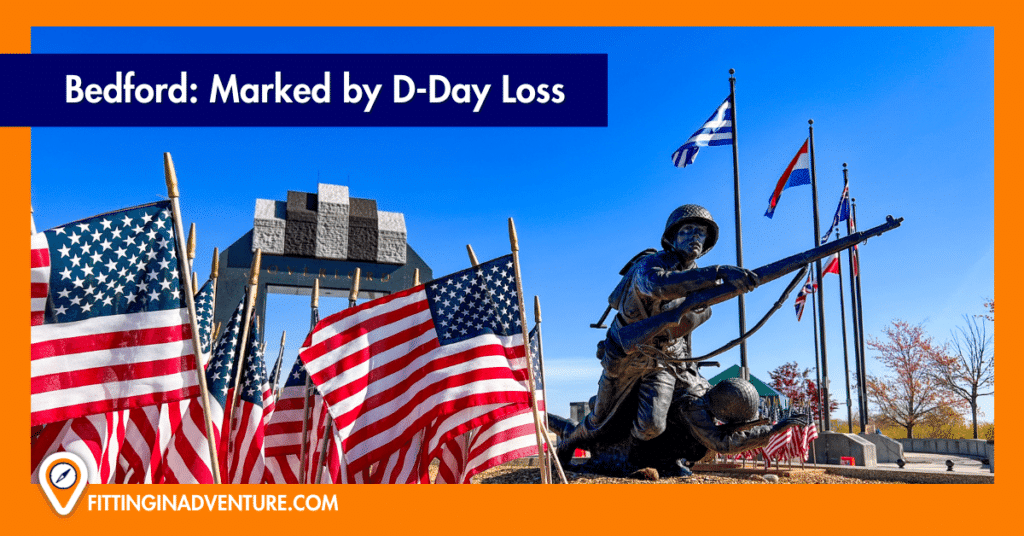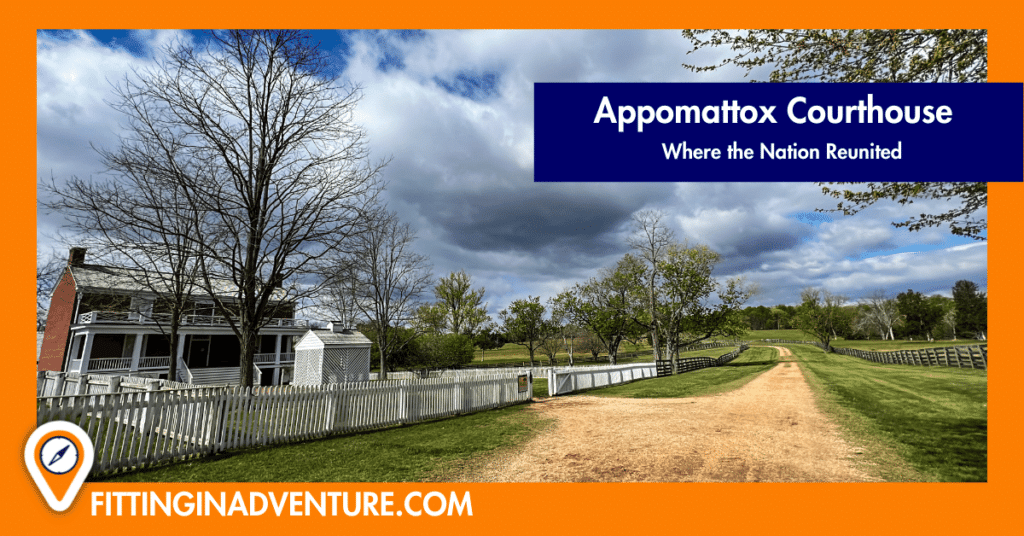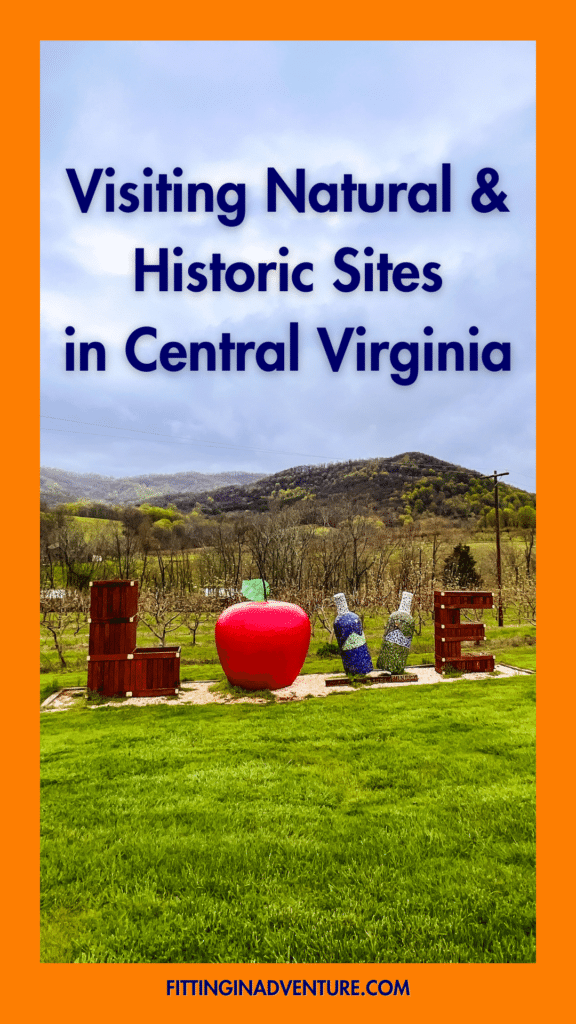The nation’s first and largest colony is, as the saying goes, “for lovers” with its marriage of historic locations and rolling hills. Leaving visitors with ample opportunities to explore and/or relax.
Disclosure: Some links on our site are affiliate links. If you purchase a linked item, we will make a commission, at no extra charge to you.
Welcomed. If you had to use one word to describe your feelings while visiting Central Virginia, it would be welcomed. Sure many locations love having tourists, but there is a difference between loving the tourism dollars and welcoming the visitor. Bedford and its surrounding area is the type of place that makes you feel as if a local will shout out from their porch as you pass by. Inviting you inside for some warm peach cobbler. Of course, the peaches would be homegrown and the orchard has been in their family for decades or centuries. And of course, you would sit and chat like old friends for hours. And yes, we had amazing peach cobbler and meant many “old friends” during our visit.
Bedford serves as a great “base camp” for a central Virginia adventure. The historic small town with local lore offers an abundance of natural beauty with the comforts of great restaurants, beer, and wine.
The Legend of the Beale Treasure
In 1820, a mysterious man arrived at the Washington Hotel. During this and a subsequent stay, he befriended the hotel manager, Robert Morris. Morris described Beale as 6 foot tall with jet black eyes and hair (worn longer than average for the time) and a dark swarthy complexion. He went on to state Beale’s stature gave evidence of unusual strength and a “model of manly beauty favored by ladies and envied by men.” Morris stated he was a man of kindness unless the “lion was aroused” when someone crossed him.
The friendship caused Beale to leave a metal box with Morris on his second trip to the area. With instructions to open the box if he didn’t return. Years passed and Beale never returned to retrieve the box from Morris. Upon opening the box, Morris discovered three pages of numbers and a letter. The letter stated the other pages were ciphers. Describing a treasure Beale and his crew had discovered out west (currently the New Mexico/Colorado border area). The ciphers when decoded would explain the treasure itself, where it is, and who has a legit claim to the treasure. 200 years later only one has been decoded using the Declaration of Independence. (Sound familiar? You can find a movie loosely based on the story here – National Treasure). The decoded cipher describes a treasure worth millions. Treasure hunters still arrive in the area today. All are sure that they have cracked the code of the Beale Ciphers and know where to locate the famed treasure. Many have acquired large debt to try, but no one has succeeded.
You can read about my own Beale Treasure discovery while sorting through my dad’s Beale ancestry papers here. My own Beale book is pending in which I plan to share my discoveries regarding what really happened to the Beale Treasure. You can follow along the process here on FittinginAdventure.com or sign up for our email list (bottom of the page).
Bedford, VA Facts:
- Nestled against the eastern edge of the Blue Ridge Mountains at the foot of the Peaks of Otter range resulting in some of the most beautiful scenery in Virginia.
- The population of less than 7,000.
- The town spans just under 7 square miles.
- Originally founded as the village of Liberty in 1782. The village became a town in 1839.
- The town was devastated by a fire in the late 1880s which led to the town being rebranded into Bedford City in 1890.
- Home to the National D Day Memorial which is our nation’s only privately funded national memorial.
- Bedford was chosen as the home for the National D Day Memorial due to its loss on that day. The town lost more (per capita) than any other town in the United States. The 19 lost that day combined with the three lost in the Normandy invasion are known as the Bedford Boys.

The National D-Day Memorial
On June 6, 1944, Allied forces landed on the French coastline to expel German soldiers from Western Europe. That day one of the most pivotal battles of World War II was fought. To honor those soldiers The National D-Day Memorial was established. Poised atop the highest hill in Bedford sits the memorial dedicated to the valor and sacrifice of all the Allied D-Day participants.
Dedicated in June 2001, the memorial is the only national memorial to be privately funded. Visitors enter under the Overlord arch to witness the bronze sculptures of men climbing up from the “beach” as fountains create a chaos of noise. Peeking over the soldier’s shoulders you see the “beach” and replica Higgin’s Boat while fountains burst as if gunfire is still erupting around them.
The Memorial continues with the gardens and necrology wall bearing the names of the 4,400 Allied soldiers who lost their lives on that day.
The National D-Day Memorial is located just behind the Destination Bedford Welcome Center. Admission fees apply. Visit their website to plan your visit.
Bedford Boys Homefront Tour
While the National D-Day Monument pays tribute to all who lost their lives during the invasion of Normandy. The Bedford Boys Homefront Tour gives you an insight into the “boys you wish you knew” – the Bedford Boys. The walking tour around Bedford allows you to see the way that day on a beach in France has continued to shape the town.
Bedford’s Factories: Smyth ( Formerly Piedmont Label) The factory opened in 1919. It is Bedford’s oldest factory in continuous operation.
Bedford High School – The Bedford Boys attended school here and a farewell dance on February 17, 1941. A plaque was added for the class of 1944 outside the school.
County Courthouse: Bedford Boys Monument – Ten years after the Normandy invasion, the community dedicated a monument to its lost sons.
Fisher’s Restaurant – A traditional 1940s diner where locals would gather.
Liberty Station – The railroad station was the hub and where the Bedford Boys left from. The building is now renovated into a great restaurant, but still holds many of its original pieces.
Centertown Plaza – February 1941, Company A of the 116th Infantry Regiment, Virginia National Guard, said goodbye and boarded a waiting train.
Green’s Drugstore (now Bedford Boys Tribute Center) – A chilling stop on your walking tour. Green’s Drugstore is where the word came in that Bedford had suffered such loss that day. The soda fountain jerk jumped on his bike to notify families. While one young girl continued to get the telegraphs with help from regular customers. The center is now filled with letters and artifacts.
Bedford Museum & Genealogical Center
Originally built as a Masonic Temple, the Romanesque revival building now houses Bedford County Museum. Inside this downtown Bedford building, you will find local history related to the Civil War, World War I and II, a special D-Day exhibit, and rooms dedicated to the regional history of Native Americans and African Americans.
Free to the public, donations are suggested. Visit their site for information on hours and genealogical research.
Nearby Attractions: Historic and Nature
Blue Ridge Parkway
Take a beautiful drive to enjoy the nature of the Appalachian Mountains. 469 miles meandering atop the Blue Ridge Mountains is America’s most visited national park. The Parkway is often called America’s Favorite Scenic Drive. The road connects Skyline Drive in Shenandoah National Park in the north and the Great Smoky Mountains National Park in the south.
Numerous scenic overlooks & trailheads allow visitors to appreciate the views at a slower pace.
Check the website before your trip. Parts of the road will close due to weather or repairs.
Peaks Of Otter
Peaks of Otter is one of the most popular stops along the famed Blue Ridge Parkway. This stop consists of three peaks which are a part of the Blue Ridge Mountains. Consisting of Sharp Top (3,875 feet), flat Top (4,004 feet), and Harkening Hill (3,375 feet).
Peaks of Otter Name Origin: Some say the area is named after the Cherokee word for high places. While others claim it was named by the first settlers to the area from Scotland in 1750 after their memories of Scottish mountains.
Historical Note: Thomas Jefferson built both his homes (Monticello and Poplar Forest) nearby. He was convinced that Sharp Top was the tallest mountain in the United States. Jefferson and his friends used chains in 1815 and trigonometry to estimate the height of the mountain. Jefferson was wrong. The peak is not even the tallest in Virginia. Virginia’s tallest peak is Mount Rogers.
The area offers ample hiking and outdoor activities. Keep in mind, that the lodge and some areas are seasonal.
The Peaks of Otter Lodge is located at milepost 86 on the Blue Ridge Parkway
About a mile from the Peaks of Otter Visitor Center (seasonal hours) you will find the Johnson Farm. The farm was rehabilitated by the park service in 1974 and is often noted as the best living history stop along the Blue Ridge Parkway. The simple tin-roofed home captures the life of mountaineers in the early 1900s Southern Appalachians before the construction of the parkway changed their lives.
The home on Harkening Hill sits on a parcel of the 102.5 acres purchased in 1852 by John T Johnson and his wife, Mary. The home remained in the family until it was sold to the park service in 1941. You can visit the nearby farm of John T Johnson’s descendants at Peaks of Otter Winery & Orchards.
Peaks of Otter Winery & Orchards
This six-generation family farm is nestled beneath the Peaks of Otter. Today they farm fruit trees and grapes for wine and their family’s recipe A-peeling Apple Butter (highly recommended).
For those interested in the Beale Treasure, you may recognize the family’s patriarch Danny Johnson as a local expert on the legend. Danny’s stories of hunters seeking the treasure accredited to my own ancestor while sipping his great wine made for a great afternoon! More on that in the future…
Thomas Jefferson’s Poplar Forest
Often called a masterpiece of landscape architecture, Thomas Jefferson’s personal retreat, Poplar Forest was built on his Bedford County plantation in 1806. The house sits in a modern residential neighborhood in Forest, VA. The home design allowed Jefferson to implement all he had learned. With no one to please but himself, the concept is highly idealistic with few concessions to practicality. The octagon neoclassical structure is where Thomas Jefferson came to renew his creativity. Visiting three to four times per year after his presidency ended. The area is just 80 miles from his Monticello home.
Now designated a Historical Landmark, the home was nearly lost to development until it was rescued by a group of local citizens in 1984. The restorations have been ongoing as the home is restored to its former state.
A visit through the property offers a unique opportunity to discover the world of Jefferson and learn about the free and enslaved people “who labored for his happiness.”
Poplar Forest is located in Forest, Virginia. Check their site for hours. The site is open from April through November. Admission fees apply.
Thomas Jefferson’s Monticello

No trip to central Virginia could be complete without a tour through the beautiful estate of Thomas Jefferson. Located south of Charlottesville on the “best price of Virginia soil” according to Thomas Jefferson. The hilltop estate of Jefferson offers a rich visitor experience with a glimpse into Jefferson’s life.
While the house structure is not as large as you may think the property hold beauty and artifacts across its acreage. Parking leaves you near the Visitor’s Center and Museum. The ticketing offers a variety of choices. (Insert link) Choose the option you feel is best for your interests, but keep in mind the property will be busy. We were there on a weekday in April and it was packed!
A walk through the museum exits to a trolly stop. Here you are given a choice. Take the trolley up the mountain to Monticello or take a short unpaved walk (about ¾-mile) through the forest and past the Jefferson Family Cemetery. (Hint: Choose the walk at least one way)
The tour thought the home offers viewing of many original items. This is due in part to Uriah Levy. Levy was a Jewish-American who admired Jefferson’s commitment to religious freedom. During the estate sale to settle Jefferson’s debts, Levy purchased many items (including the estate). Levy owned the home for 90 years with many of the items in their original locations due to the help of a hand-drawn map by Jefferson’s granddaughter.
The home also contains multiple paintings and busts of Jefferson’s historical friends and foes. A bust of Hamilton is in the home when asked about it, Jefferson replied, “we will be opposed in death just as in life.”
Did you know? Thomas Jefferson died on July 4, 1826, fifty years to the day after the signing of the Declaration of Independence. His last words? “Is it the fourth?”
Visit the Monticello website for complete information on hours, types of tours, and ticketing fees.

Appomattox Court House: Where our Nation Reunited
In a state filled with American historical locations, few had the impact on our nation like Appomattox. On April 9, 1865, in a small farmhouse owned by the McLean family, General Robert E Lee of the Army of Northern Virginia surrendered signaling the end of the Civil War.
The surrender answered two questions:
Could the nation survive a civil war intact?
Would the nation exist without slavery?
The answer to both was yes and the nation reunited.
The park offers hiking trails and building exhibits. Head to the Visitor’s Center or online first to watch the 17-minute video before wandering the buildings. The McLean house is furnished with period pieces yet the parlor still carries the weight of the day two generals who had fiercely fought each other became the catalyst to piece for our nation.
Visiting Appomattox Court House National Historic Park was free at the time of this writing. Visit their site for the current hours.
Booker T Washington National Monument
Born a slave on the Burroughs farm in 1856 and freed with the conclusion of the Civil war, Booker T Washington became the first principal of the Tuskegee Institute in Alabama. The home he lived in for his first nine years of life is designated a national monument giving visitors a chance to reflect on that time in our nation’s history.
“The first time I got a knowledge of the fact that my mother and I were slaves, was being awakened by my mother…kneeling over me…praying…that someday she and her children might be free.” – Booker T Washington, The Story of My Life and Work, 1901
“Finally the war closed, and the day of freedom came. It was a momentous and eventful day to all on our plantation.” Washington described the moment in his book Up From Slavery. He recalled a stranger coming to the plantation to read what he recalls as the Emancipation Proclamation. “After the reason, we were all free and could go when and where we pleased. My mother, who was standing by my side leaned over and kissed her children, while tears of joy ran down her cheeks.”
Lexington Historic Walking Tour
More historical sites are waiting in Lexington. Taking a walking tour through the cities downtown and the Virginia Military Institute area is a great way to spend the afternoon. The tour will take you past many quaint and tasty restaurants to refuel along the way.
Stonewall Jackson’s House Museum
Thomas J “Stonewall” Jackson’s former home and a collection of period pieces make up this museum. The on-staff docent will provide historical information about Stonewall’s life as a professor at Virginia Military Institute and church leader, his wife, and slaves. If you choose the self-guided tour, QR codes are available to give you additional information.
Find information on the tour hours and pricing on their website.
Natural Bridge State Park

Words cannot describe, nor can photos due justice to the impressive geological formation that is Natural Bridge State Park. This 215-foot tall natural bridge of limestone has been carved over the course of centuries by the flowing water of Cedar Creek (a tributary of the James River).
The bridge was privately owned for nearly 250 years. Thomas Jefferson was a notable owner. He purchased the bridge with 157 surrounding acres in 1774 from King George III of England for 20 shillings.
Jefferson hired a caretaker for the property who lived on the property and took people down to view the bridge. The caretaker was Patrick Henry.
Sips in Bedford
Peaks of Otter Winery: Listed above under Peaks of Otter. The winery offers tastings and tours. Be sure to try Beale’s Treasure wine!
Beale’s Beer: Craft beer named in honor of the town’s local legend.
Tips for RVers Visiting Central Virginia
- Pick a “base camp” to leave the RV while you venture out. We chose Bedford (and would again). We left the RV in Bedford while we drove out to locations. The mountain terrain and narrow roadways would not be fun in an RV.
- Harvest Host locations are abundant in the area when you are moving.
- Be sure to check your RV GPS. You will see signs about tunnel bridges and hills that cause an issue for longer rigs.
- Destination Bedford offers a couple of sites on a first come first serve basis.
